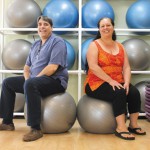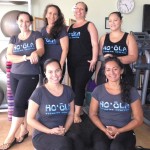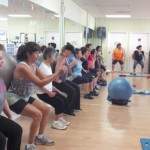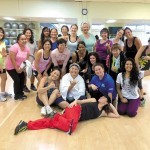For The Health Of It
Having lost her father too early to diabetes, Marla Silva of Ho’ola Lahui Hawaii strives to make Kauai a healthier place.
Marla Silva had a difficult time watching family members struggle with health issues to which many Native Hawaiians sadly succumb.
Her father, Moses K. Keale Sr., who was pure Hawaiian, was an OHA trustee for 19 years. He died in 2000 at the age of 62 from complications of diabetes.
- Ho’ola Lahui Hawaii provides medical and preventative health care at a lower cost to the community. Silva and Peters help make the nonprofit tick. Coco Zickos photo
- HLH Fitness Center instructors: (front, from left) Jayme Hashimoto, Lisa Abell, (back) Chacha Nash, Anna Velasco, Marla Silva and Kureen Medeiros. Photos courtesy Ho’ola Lahui Hawaii
She says, “He was in the prime of his political career, cut short because of his failing health.
“As we see it happening to people we care about, and how prevalent it is within your community, you try to figure out the ways you can help.”
Silva is program director for Ho’ola Lahui Hawaii (HLH) — a nonprofit committed to providing a myriad of medical and preventative health care services for the community, from fitness classes to substance abuse counseling. The health center targets Native Hawaiians and underserved populations, such as those with Medicaid or who are uninsured.
Responsible for managing the organization’s fitness center in Lihue, Silva has held her current position about 15 years, but began working at HLH as an outreach worker.
HLH’s chief executive officer David Peters has worked for the nonprofit almost as long as Silva has, and he also feels a strong commitment toward improving overall health in the community, as well as helping to lower the escalating costs of health care.
“We’ve made a pretty significant impact,” he says.
- Silva teaches a Strength and Tone class at Ho’ola Lahui Hawaii Fitness Center
- One of HLH’s Zumba classes with instructor Kawehi Aname
When HLH opened its medical clinics in Kapaa (2004) and Waimea (2001), many of the new patients hadn’t seen a doctor in decades. Today, patients have the opportunity to see health care providers, including doctors, dentists, clinical psychologists, licensed social workers who offer services on a sliding-fee scale, as often as needed. And because HLH is a federally qualified health center, medicine also is provided at a lower cost at its pharmacy in Lihue.
People from all ranges of the economic spectrum can take advantage of HLH’s various programs, although most of the clientele fall below 300 percent of the federal poverty level.
“It’s hard for a lot of folks who are working and really trying to make ends meet, but are not making it. That, to me, is one of the biggest challenges we have to overcome,” explains Silva. “It’s hard for people to think in a healthy light if they can’t buy the right food to eat because it costs them too much money.”
Nutritional advice and healthy cooking demonstrations are just a couple of the many ways HLH helps those in need.
“I know that we can make a difference,” adds Peters, who says he gets a “big kick” out of changes that take place within individuals because of HLH’s services.
Silva, who also enjoys seeing clients become successful in their journey to better health, is notably proud of those attending her fitness classes who initially didn’t believe in their abilities. Once they overcame their insecurities, they started completing the classes, began participating in more and enjoyed the added benefit of making friends — a social aspect to a healthy life.
An array of workout options for people at any level, including Zumba, Ripped and Yoga, are taught Monday through Saturday starting as early as 5:30 a.m. and ending as late as 5 p.m. at HLH fitness centers in Lihue, Waimea Plantation Cottages, Kapaa Neighborhood Center and Anahola Neighborhood Center.
And HLH doesn’t cater only to adults. The nonprofit, which was founded in 1986, also assists keiki in maintaining healthy lifestyles through programs such as Malama I Na Pua, which brings physical activities, like Capture the Flag, every other week to Hawaiian-speaking schools Punana Leo, Kawaikini and Ke Kula Niihau O Kekaha. HLH provides dental screenings for the kids each year, and also sends a dietitian to the schools to help teach them how to prepare healthy foods.
Silva says the number of services HLH offers now, compared to when she started working, is “mind-blowing.” Peters recalls that, when he came on board in 1998, there were 10 people on staff with a $500,000 budget.
Now, there are 60 employees with a $7 million budget. In 1992, HLH served approximately 400 people annually. Today, that number has climbed to more than 7,000.
“I love to see the community grow and get better,” says Peters.
Visit hoolalahui.org for more information.
cocomidweek@gmail.com







